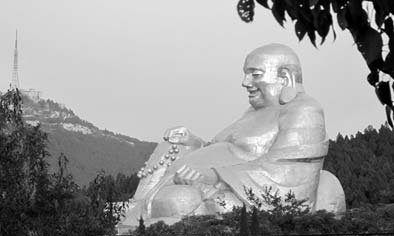|

A Maitreya - or fat smiling Buddha - in Jinan, capital of Shandong province. The court ruled that traditional Buddhist images can be copyrighted if they have "innovative elements". Wang Hui / China Daily
|

Traditional religious images can be copyrighted if they contain "innovative elements" created by artists, according to a recent Beijing court ruling that found sculptor Huang Quanfu owns the rights to a wood sculpture design for Maitreya - the so-called fat smiling Buddha.
The ruling came in a lawsuit filed by Huang after he found a shop in Beijing's Haidian district selling woodcarvings that looked like his own works.
An advertising leaflet in each package even boasted that the shop "provides Huang Quanfu's series of Buddha works", the court heard.
After the discovery, Huang's sued the shop and Aika International Collections Market, where the shop was located, claiming that they used his work without authorization.
He said he created two series of wood Maitreya sculptures in 2005 and registered copyrights for them in 2007 with copyright authorities in Fujian.
The shop owner, surnamed Cao, countered that the Maitreya sculptures sold in his shop "only look like the ones Huang has copyrights to, but are not exactly the same".
"Maitreya is a typical figure in Buddhist culture and any sculptor can create a Maitreya with his own style, so there is no originality in Huang's works," said the shop owner.
But the Haidian district court found that Cao had infringed on the artist's copyright because the products in his shop are "basically the same as Huang's copyrighted ones" and he used Huang's name in advertising, on business cards and in packaging.
The court ruled that Cao must pay 60,000 yuan ($9,588) in compensation to Huang. Cao's appeal of the verdict was rejected by a higher court.
Haidian District Judge Guo Zhenhua said Huang has copyrights to the sculptures because his works "are not simply replicas of traditional Buddhist images, but have integrated his own ideas".
"The facial expressions, manners and body gestures of the Maitreya embody the creative work of the sculptor," he said.
"The protection of traditional culture mainly focuses on the creative elements, but it is very difficult to decide which are creative," said Guo. "It is important to make records using words and pictures during the creation of a work based on traditional cultural elements."
He also suggested cultural administrations improve their systems and standards to encourage artists to register copyrights and make it easier to prove infringement.
The second defendant, Aika International Collections Market, was found not guilty, because it is not responsible for the business operations in individual shops, the court ruled.
"The market has some economic connections with the shop, but it is difficult to prove that it has obtained direct benefit from a single case of the shop's infringement," Guo said.
zhangzhao@chinadaily.com.cn
(China Daily 10/24/2012 page17)


